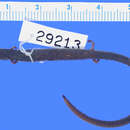Description
provided by AmphibiaWeb articles
Diagnosis: O. pseudouniformis can be distinguished from other members of its genus by coloration pattern and the combination of its moderate costal groove numbers, long limbs, a high number of maxillary teeth, and a broad head and foot. It is distinguishable from O. poelzi by its shorter limbs and smaller feet. O. pseudouniformis also has a black body and orange to brown limbs in comparison to the brown stripe and silver stripes in O. poelzi. O. pseudouniformis has a broader and rounder head as well as a larger size in comparison to O. cyclocauda (Brame 1968). Description:O. pseudouniformis is a member of the uniformis group and has many similarities. The snout-vent length of this salamander is 50.2 mm. It has 19-20 coastal grooves per side and 23 left and 23 right maxillary teeth. It also has 8 left and 9 right vomerine teeth. The mental gland can be seen as two triangle patches on the chin. The nostril, labial protuberances and snout are small. A postorbital groove extends from the eye and across the gular area. The tail is thick, compressed laterally and has a mild constriction at the base. Limbs are long and the fingers and toes are thick. The toes are partially webbed (Brame 1968).Coloration: This salamander is jet black dorsally, with faint orange dorsal patches and light grey-black ventrally. A pale white region is present anterior to the gular fold. Black coloration surrounds the vent. The upper lip is light colored, but the lower is lined with dark coloration. The limbs are brown-purple (Brame 1968). Variation: There is variation found in size between individuals of different places (Brame 1968).A Spanish-language species account can be found at the website of Instituto Nacional de Biodiversidad (INBio) (http://darnis.inbio.ac.cr/FMPro?-DB=UBIpub.fp3&-lay=WebAll&-Format=/ubi/detail.html&-Op=bw&id=4364&-Find).O. pseudouniformis was first described in 1968 by Arden Brame.This species is placed in the uniformis group (Brame 1968; McCranie et al. 2008). It is most closely related to O. cyclocauda (García-París et al. 2000).
- Bolaños, Federico, Gerardo Chaves, David Wake, Jay Savage, Gunther Köhler . 2008. Oedpina pseudouniformis. In: IUCN 2010. IUCN Red List of Threatened Species. Version 2010.4. Downloaded on 22 March 2012.
- Smits, A. W., and Brodie, E. D. Jr. (1995). ''Lack of respiratory “cost” of tail autotomy in the lungless salamander, Oedipina uniformis.'' Comparative Biochemistry and Physiology, 111A, 155-161.
Distribution and Habitat
provided by AmphibiaWeb articles
Many of the species are found from western Nicaragua, to Costa Rica (Brame 1968; McCranie et al. 2008). This salamander resides in moss covered, east facing slopes, in the swamps and in the deep woods under logs, living at elevations from 215 – 1220 ft (Bolaños et al. 2008; Brame 1968).
Life History, Abundance, Activity, and Special Behaviors
provided by AmphibiaWeb articles
O. pseudouniformis does not require water for breeding and exhibits direct development (Bolaños et al. 2008).Like other members of the uniformis group, this species has an easily detachable tail and displays a flipping behavior, supposedly to ward off predators or escape their grasp (Smits and Brodie Jr. 1995).
Life History, Abundance, Activity, and Special Behaviors
provided by AmphibiaWeb articles
At one point, this salamander was very common, but has recently declined. The last specimen was collected in 1996, so little is known about the rate of decline. The suspected cause via human activity, is settlement, wood harvest, and agricultural activities (Bolaños et al. 2008).

